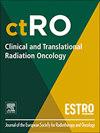Patterns of prostate recurrence after focal salvage prostate brachytherapy for radiorecurrent prostate cancer
IF 2.7
3区 医学
Q3 ONCOLOGY
引用次数: 0
Abstract
Background and purpose
Focal high-dose-rate (HDR) salvage brachytherapy has emerged as a treatment for radiorecurrent prostate cancer. This study aims to evaluate patterns of recurrence after focal salvage brachytherapy and to assess the adequacy of current treatment margins.
Materials and methods
Between March 2015 and December 2021, 39 patients with radiorecurrent prostate cancer underwent focal HDR brachytherapy. All patients had biopsy-confirmed local recurrence and were staged using Choline- or PSMA-PET/CT and multiparametric MRI. A 5 mm margin around the GTV was applied to define the CTV. Post-treatment recurrences were analyzed using rigid image registration of PET/CT and MRI to assess spatial relationships among the initial recurrence (Rec1), the recurrence following salvage brachytherapy (Rec2), and the brachytherapy dose distribution. The recurrences were categorized into infield, marginal, and outfield based on overlap of relapse with the treated CTV and based on dose received on the site of the relapse. Additionally, spatial analysis measured minimal distances between Rec1 and Rec2.
Results
Nineteen of 39 patients experienced clinical recurrence, with 12 exhibiting 25 local lesions. Based on spatial overlap, 20 % of Rec2 lesions were infield, 28 % marginal, and 52 % outfield. Dose-based classification indicated 52 % infield, 8 % marginal, and 40 % outfield recurrence. The median distance between Rec1 and Rec2 in outfield cases was 11.9–13.4 mm.
Conclusion
A substantial proportion of local recurrences after focal salvage brachytherapy occur outside the treated volume. Current 5 mm margins may be insufficient.
放射复发性前列腺癌局部补救性前列腺近距离治疗后前列腺复发的模式
背景和目的局灶性高剂量率(HDR)抢救性近距离放射治疗已成为放射复发性前列腺癌的一种治疗方法。本研究旨在评估局灶性挽救性近距离放疗后的复发模式,并评估当前治疗范围的充分性。材料和方法2015年3月至2021年12月,39例放射复发性前列腺癌患者接受局灶性HDR近距离放疗。所有患者活检证实局部复发,并通过胆碱或PSMA-PET/CT和多参数MRI进行分期。用GTV周围5mm的边缘来定义CTV。使用PET/CT和MRI的刚性图像配准分析治疗后复发,以评估初始复发(Rec1),补救性近距离治疗后复发(Rec2)和近距离治疗剂量分布之间的空间关系。根据复发与治疗CTV的重叠程度和复发部位接受的剂量,将复发分为内场、边缘和外场。此外,空间分析测量了Rec1和Rec2之间的最小距离。结果39例患者中有19例出现临床复发,其中12例出现25个局部病变。基于空间重叠,20%的Rec2病变位于内野,28%位于边缘,52%位于外野。基于剂量的分类表明52%内野复发,8%边缘复发,40%外野复发。外场病例Rec1和Rec2的中位距离为11.9 ~ 13.4 mm。结论局灶性挽救性近距离放疗后,相当一部分局部复发发生在治疗容积外。当前5mm的间隙可能不够。
本文章由计算机程序翻译,如有差异,请以英文原文为准。
求助全文
约1分钟内获得全文
求助全文
来源期刊

Clinical and Translational Radiation Oncology
Medicine-Radiology, Nuclear Medicine and Imaging
CiteScore
5.30
自引率
3.20%
发文量
114
审稿时长
40 days
 求助内容:
求助内容: 应助结果提醒方式:
应助结果提醒方式:


